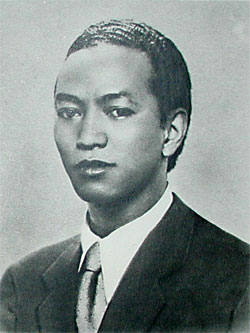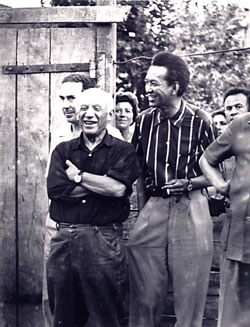 |
 |
|
|
Biography
 Wifredo Lam was born in Sagua la Grande, Cuba, on December 8, 1902. He was the eighth child born to Lam-Yam―born in Canton around 1820, an immigrant to the Americas in 1860―and to Ana Serafina Catilla―born in 1862 in Cuba of mixed African and Spanish ancestry. The luxuriant nature of Sagua la Grande had a strong impact on Lam from early childhood. One night in 1907, he was startled by the strange shadows cast on the wall of his bedroom of a bat in flight. He often recounted the incident as his first magnificent awakening to another dimension to existence. In 1916, Lam and part of his family settled in Havana. He was enrolled in the Escuela Profesional de Pintura y Escultura, Academia de San Alejandro, where he remained a student until 1923. This period, with exhibitions at the Salón de Bellas artes, was determinant in his choice to become a painter. In 1923, the municipality of Sagua la Grande awarded him a grant to study in Europe and by the autumn of that year, at the age of twenty-one, he left the country for Spain. His time in Spain―initially intended as a short stay on his way to Paris―lasted 14 years. In Madrid, he was exposed to the ideas and movements of modern art. He spent long hours at the Archeological Museum and the Prado. He studied the great masters of Spanish painting, Velázquez and Goya, but felt particularly drawn to the works of Bosch and Bruegel the Elder. He discovered surprising correlations between western art and so called “primitive” art. In 1931, his first wife, Eva (Sébastiana Piriz) and their son Wilfredo Victor died of tuberculosis. The terrible suffering he endured led to numerous paintings of mother and child. Lam found solace in the company of his Spanish friends and made contact with several political organizations. In 1936, with the help of his friend Faustino Cordón, he joined the Republican forces in their fight against Franco. He designed anti-Fascist posters and took part in the struggle by working in a munitions factory. The violence of the struggle inspired his painting La Guerra Civil. In 1938, Lam left Spain for Paris. Shortly before leaving, he met Helena Holzer, who would become his wife in 1944. His meeting Picasso in his studio on the Rue des Grands Augustins proved decisive. Picasso introduced his new “cousin” to his painter, poet and art critic friends, Braque, Matisse, Miró, Léger, Eluard, Leiris, Tzara, Kahnweiler, Zervos. Lam also met Pierre Loeb, the owner of the Galerie Pierre in Paris, which hosted Lam’s first solo exhibition in 1939. Shortly before the Germans arrived, Lam left Paris for Bordeaux and then Marseille, where many of his friends, for the most part surrealists, had gathered around André Breton in the Villa Air Bel: Pierre Mabille, René Char, Max Ernst, Victor Brauner, Oscar Domínguez, André Masson, Benjamin Péret. In the Villa Air Bel, a meeting place for creativity and experimentation, Lam worked and produced, most notably, a series of ink drawings that set the tone for what would become his signature style of hybrid figures, a vocabulary he would develop more fully during his years in Cuba from 1941 to 1947. In January and February 1941, Lam illustrated Breton’s poem Fata Morgana which was censored by the Vichy government. On March 25, Lam and Helena Holzer embarked on the “Capitaine Paul Lemerle” headed for Martinique, in the company of some 300 other artists and intellectuals―André Breton and Claude Lévi-Strauss among them. Upon arrival, the passengers were interred at Trois Îles. It was during this forced passage in Martinique and before leaving for Cuba that Lam and Aimé Césaire met for the first time to become life-long friends. Newly settled in his native land after almost twenty years, Lam delved deeper into his artistic investigations, finding nourishment for his ideas in the surroundings of his childhood and youth. His sister Eloisa, whom he was closest to, explained to him in much detail the workings of Afro-Cuban rituals and he began attending ritual ceremonies with some of his friends. This contact with Afro-Cuban culture brought new impetus to his art. He painted over one hundred canvases, most notably La Jungla, making the year 1942 his most productive of this period. Over the next few years, a number of exhibitions followed in the United States, at the Institute of Modern Art of Boston, at the MoMA of New York, at the Galerie Pierre Matisse, where La Jungla was presented and created a scandal. In 1946, Lam and Helena travel to Haiti and attend voodoo ceremonies in the company of Pierre Mabille and André Breton. Talking about his experience in Haiti, Lam said, “It is often assumed that my work took its final form in Haiti, but my stay there, like the trips I made to Venezuela, Colombia or to the Brazilian Mato Grosso only broadened its scope. I could have been a good painter from the School of Paris, but I felt like a snail out of its shell. What really broadened my painting is the presence of African poetry.” 
Wifredo Lam et Pablo Picasso, Vallauris, 1954
Lam then went on to New York where he renewed contact with Marcel Duchamp and made new acquaintances: Jeanne Reynal, James Johnson Sweeney, Arshile Gorky, John Cage, Roger Wilcox, Mercedes Matter, Ian Hugo, Jesse Fernández, John Cage, Sonia Sekula and Yves Tanguy. By the end of the 1940s, Lam divided his time between Europe, Havana and New York, where they stayed with Pierre and Teeny Matisse as well as Jeanne Reynal. He enjoyed the company of numerous artists: Noguchi, Hare, Motherwell, Pollock, Asger Jorn and the dissident surrealist group CoBrA. From 1947, Lam’s style began to show new developments: a pronounced presence of esoteric elements and a coupling of the influence of Oceanic art with that of African art. His reputation as an artist had spread internationally. Articles on Lam appeared in prestigious publications and reviews around the world such as VVV, Instead, ArtNews and View, and exhibitions of his work in the United States, Haiti, Cuba, France, Sweden, England, Mexico, Moscow and Prague. After his divorce with Helena Holzer, in 1952 Lam settled in Paris. In 1955, he met the Swedish artist Lou Laurin―the couple would marry in 1960. He wins the Grand Prix of the Havana Salon and, in 1958, is named a member of the « Graham Foundation for Advanced Study in Fine Art » in Chicago and received numerous awards, most notably the « Guggenheim International Award » in 1964. Throughout the 1950s, while maintaining close contact with Cuban art circles, Lam became increasingly involved with European artistic currents, developing close ties with CoBrA artists and the Italian avant-garde. He also joined post-war movements such as “Phases” and the Situationist movement. In 1954, Lam met the poets Gherasim Luca and Alain Jouffroy. He traveled to Italy, to Albissola, on the initiative of Asger Jorn and Édouard Jaguer who had organized an international meeting of sculpture and ceramics which included as participants: Appel, Baj, Corneille, Dangelo, Fontana, Scanavino and Matta. Encouraged by the art dealer, Carlo Cardazzo, they would transform this little Italian village on the Ligurian coast into a gathering point for artistic experimentation, from the late fifties through to the late sixties. During the 1960s, Lam’s work reflected a growing interest for engraving. Collaborating with poets and writers, he undertook several important projects in printmaking: large format portfolios, pulled and published in the print studios of Broder, Mathieu and Upiglio, most notably: La terre inquiète by Édouard Glissant (1955), Le voyage de l’arbre by Hubert Juin (1960), Le rempart de brindilles by René Char (1963), Apostroph’Apocalypse by Gherasim Luca (1965), L’Antichambre de la Nature by Alain Jouffroy (1966), Annonciation by Aimé Césaire (1969). His meeting with the master engraver Giorgio Upiglio at his studio Grafica Uno in Milan inaugurated a period of intense creativity that would last all the way up to Lam’s death in 1982. From 1964, Lam divided his time between Paris and Albissola Mare, in Italy, where he set up a painting studio in his new house. He close friends with many writers and artists, and his work would be celebrated in many exhibitions and retrospectives around the world. Jean-Louis Paudrat (Translation by Unity Woodman) |